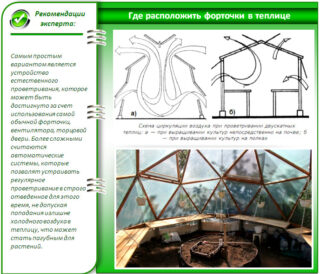A greenhouse for growing vegetables must be properly operated. In winter, it requires no less attention than in summer. Dried plants are removed from the beds, the soil is changed and cleaned, snow is thrown off the roof of the building. Some owners prefer to close the polycarbonate greenhouse for the winter, others leave it open and do seasonal maintenance.
Arguments for an open door
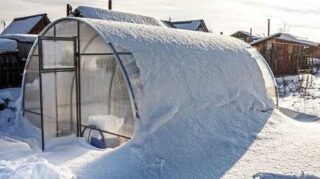
Some gardeners believe that it is not necessary to close the greenhouse door for the winter. At the same time, the interior space and equipment must be properly prepared for wintering.
They argue this opinion with facts:
- during the period of natural frosts, the room is completely disinfected, harmful microorganisms die
- frost prevents the appearance of condensation, mold;
- the greenhouse becomes ready for the new planting season over the winter.
In the fall, after harvesting, plant residues are removed, weeds are removed from the beds. Other garbage is removed and burned together with the floristic remains.
Soil cleaning is carried out in 2 ways:
- remove only the upper layer of earth in boxes to a depth of 10 - 15 cm;
- completely remove the soil from the beds, lay it again in the spring.
The remaining soil is dug inside, sprinkled with a solution of potassium permanganate, so that with the spring warming, harmful microbes and bacteria do not penetrate into the greenhouse. In winter, in the cold regions of Russia, strong winds and blizzards are observed, therefore, in the fall, they control the integrity and condition of fences and roofs. If the structures are not reinforced, snow and wind will damage the finish and render the greenhouse unusable.
Before opening the greenhouse, the wooden frame parts are treated with antiseptic agents to prevent rotting from excess moisture on snowy days.
Polycarbonate on the roof requires special attention, since disinfectants can destroy the protective layer from ultraviolet radiation.
Arguments for a closed door
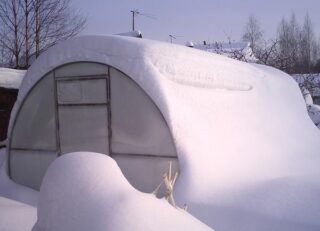
Greenhouses are advised to close in the northern regions of the country. In these areas, significant gusts of wind, together with winter frost, tear off the polycarbonate sheets, and the film is torn to pieces.
Closed door advocates argue:
- a closed door protects from a plentiful drift of snow and gusty winds;
- wild and domestic animals do not get inside;
- there is no way to rob the room, take out inventory, break the frame of the beds.
A closed room for a long time without fresh air flows accumulates condensate from internal vapors, therefore, mold develops in the greenhouse. Stagnant humid air will spoil the wooden parts of the greenhouse frame; even antiseptic preparations will not help. A green coating appears on the polycarbonate, which is difficult to remove from the surface. In this regard, the greenhouse must be properly prepared.
Before closing for the winter, the following activities are carried out:
- sweep out garbage, organic matter, the remains of trunks and leaves of vegetable crops from the premises;
- check insect nests in corners and crevices, remove them;
- close up all the cracks to the outside, preventing drafts;
- wipe washable surfaces with a damp cloth;
- the elements of the beds (sides, flooring) are treated with a soap solution after removing the soil;
- the tree is impregnated with antiseptics;
- the room is disinfected by smoking it with sulfur, sprinkling with a solution of bleach;
- steel elements in the structure are painted over with oil paints, pentaphthalic enamels.
In winter, the surrounding area is cleared of snow in order to reduce the absorption of melt water, to reduce the influence of soil moisture on the elements of the fence. Ice-covered snowdrifts melt slowly, reducing the rate of heating of the soil after winter with the onset of spring.
Condensation in the greenhouse
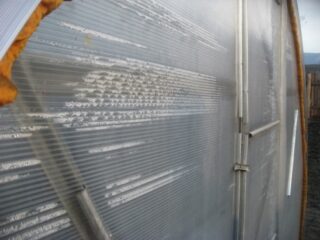
The reasons for the appearance of condensation in winter in a greenhouse:
- in winter, the sun warms up the walls of the greenhouse a little, drops appear on the ceiling and walls from the difference between the internal and external temperatures;
- uncleaned parts of plants emit carbon dioxide, the remaining moisture evaporates, which settles on the inner surfaces.
At first glance, drops on the plane of polycarbonate are harmless, but they are harmful in the form of powdery mildew, mold, late blight, root rot, spider mites that have settled inside. These microorganisms will survive the cold inside a closed greenhouse, and in spring they will harm crops with renewed vigor. High humidity deteriorates the metal of the frame, the polycarbonate filling of the roof becomes moldy.
Water droplets on the walls of the greenhouse begin to expand when freezing, so the top layer of wood, polycarbonate, cracks. If the greenhouse is closed, there will be more such water particles and the risk of destruction will increase.
Experts recommend opening a polycarbonate greenhouse for the winter to reduce the destructive effect of condensation and microorganisms.
Looseness and breakage
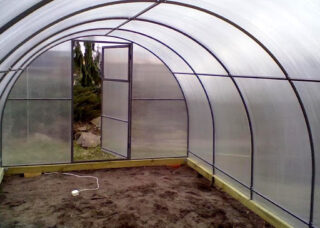
The safety of the moving parts of the structure, for example, window sashes, door leaves, is important. Open doors and windows are affected by wind, snow, wet rain.
Breakdowns and their causes:
- unfixed sashes of window frames come off in a strong wind, glass breaks in them from impact;
- unreinforced canvases of the entrance opening will clap with vortices, blizzards, may break;
- the open elements are affected by gravity from adhered and frozen snow, they sink under the weight;
- loosened hinges work successfully in good weather, but in extreme frost conditions, blizzards do not withstand, they bend;
- if thin polycarbonate is installed, the sheets may crack when hit by icy particles;
- a greenhouse can fly away to a neighboring area in a hurricane, the frame will break.
Prepare the structure for wintering before opening the doors and transoms of the greenhouse. If possible, the owner must remove the window sashes and door leaf. Otherwise, they are fixed so that they do not vomit in the wind.
Window transoms are tied in the open position, a support is placed under them to withstand the snow mass. The doors are fixed to the wall, pegs are driven into the ground. Wooden spacers are placed inside so that the adhering snow on the roof does not push through the roof. Check the awnings, if the screws are loosened, they are tightened. The open ends on the cut of polycarbonate sheets are covered with plates so that moisture and snow do not get into the honeycomb.
Installation of windows with automatic opening
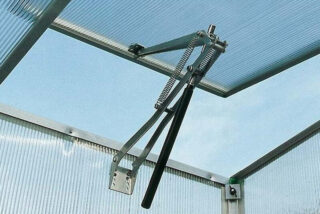
Transoms with periodic automatic opening are used in greenhouses in winter. This is an improved air vent design. The system will require an electrical power source.
When the temperature rises to the set value, the sensor and the thermostat activate the engine. The motor uses a system of levers to move the sash. When the temperature drops, the machine also works, the lever lowers the transom, the window slams shut.
The machine is chosen depending on the square of the greenhouse and the dimensions of the window sash:
- On heavy transoms, arranged on the roof, they acquire a powerful unit, since it is difficult to lift such a structure, for this they use hydraulic oil types of engines.
- For side and not too heavy ceiling flaps, pneumatic units are chosen.
- The opening of the light side windows can be controlled by a bimetallic drive.
A certain number of transoms are required for ventilation in winter to be successful. To do this, for 2 running meters, the walls of the greenhouse provide for one opening opening. It is better to place them in a checkerboard pattern on both sides.
The total area of the opening sashes should be one fourth of the glazing squared. If the greenhouse is divided into parts by partitions, ventilation is organized in each of them.
Ventilation arrangement
Forced ventilation in a closed greenhouse in winter provides:
- maintaining normal temperature;
- decrease in humidity;
- inhibition of the activity of microorganisms.
The fans turn on manually or put automatic thermostats with a motor so that they start when the set temperature or humidity is reached. Select an appliance that can operate in humid environments.
The productivity of the fan, which must process a certain volume of air per hour, is taken into account. In a greenhouse with a volume of 10 m³, two fans are installed at opposite ends. Provide for location above the door, sometimes mounted in the roof structure.
For the winter, the fastening of the device is strengthened.
The combination of natural and forced air supply works effectively.

